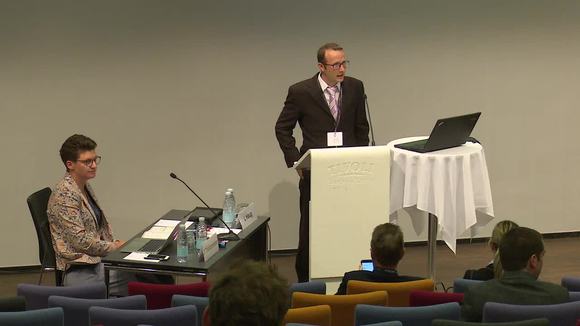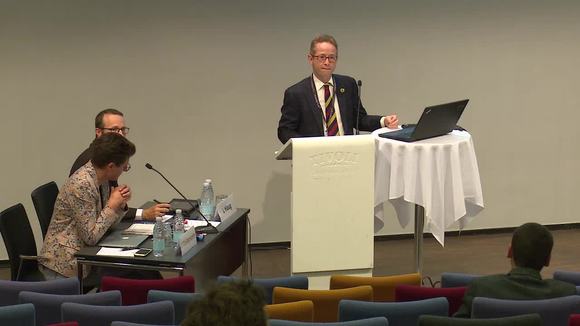Player is loading...
A-0482 Pisiform Excision; a solution for a long-term ulnar sided wrist pain. A retrospective analysis, comparing pre- and postoperative measurements
M.V. van Burink, S. Al Shaer, J. van Rossen, A. Fink, H. Slijper, T. M. Moojen, H. Rakhorst, G. van Couwelaar, R. Feitz, O.T. Zöphel, Xpert Clinic, The Netherlands
Friday, June 15, 2018 · 2:35 p.m. · 05m 44s
Embed
Embed code is not allowed
This talk is part of a Private webcast, embeding is not permited.Transcriptions
Note: this content has been automatically generated.
00:00:00
production let some gentleman
00:00:04
so we ask ourselves what with our patients when we uh excise the p. c. for about
00:00:10
what is a what is the pain that is relieved at what our deepest
00:00:15
party outcomes we offer these operations to patients with oversight wrist pain
00:00:20
uh mostly due to p. t. osteoarthritis or ten you know like this the repartee
00:00:25
or post traumatic pain and a lot of times we see a mix of diagnosis
00:00:31
when non surgical treatment is insufficient we can excise the p. c.
00:00:34
for bone and uh you know what to know about it
00:00:39
if we look at the known literature we see all studies with a maximum of sixty six patients
00:00:46
and all the studies reports high amounts of pain relief or two hundred percent
00:00:51
but none of the studies they they see how much pain relief stories
00:00:58
if they look at strengthen rest function they all say there's no difference prix operatives and post operative
00:01:04
with great strength and function but none of the studies uses outcome measurements
00:01:09
so we don't know what is really yams come after the separation
00:01:15
so what we did we uh perform to multi centre and allies as
00:01:19
of eleven different and surgical locations between two thousand eleven at fifteen
00:01:24
and the data was collected you said using a prospective clinical
00:01:28
registry so every patients which is operated in this
00:01:33
um in this clinic is prospectively respectively
00:01:37
measured prayer productive and post operative
00:01:41
all the data is web based database so we can search this uh data for whatever we want
00:01:47
and we use a pain as a primary outcome and range of
00:01:52
motion grip strength wrist function a secondary complications of course
00:01:59
so he got um our results we operated to hundreds
00:02:03
of no one hundred seventy five patients most
00:02:06
of them were female eighty percent and most of them seventy percent had b. d. osteoarthritis
00:02:14
three different kinds of surgery were used and around eighty percent
00:02:20
the basic form boneless excise trudy f. c. you we didn't see any differences
00:02:25
in the three techniques but in the other two there are very few
00:02:29
to complications occurred little bo tree that
00:02:33
and when we look at the first measurements that we see that pretty operative that
00:02:38
most patients had a fossil fife and there was improvements to advance of one until three months
00:02:45
so that's the same as the other studies reports but after three months no um bettering is expected
00:02:54
all the studies didn't report any uh differences in range of motion we yeah
00:02:59
we get so see some difference in flexion and extension of the rest
00:03:03
but was only thirteen percent real over deviation uh was not improved and
00:03:09
also we looked at prosody nation but nothing to see there also
00:03:15
we did see some improvement in the red strength that improved uh twenty percent
00:03:21
uh in comparison with pretty operative measurements and almost
00:03:25
tale a mean of twenty seven kilograms
00:03:28
and the mean of the unaffected wrist was thirty kilograms so there's a
00:03:32
big improvement thing grip strength after you excise the basic form button
00:03:37
at last we looked at the wrist functioning your for we use the patients rated
00:03:41
wrist and evaluation questionnaires it's a little bit the same as the dash course
00:03:46
um in this core there's a maximal off a hundred
00:03:51
points which indicates maximal and a can of the
00:03:54
wrist and minimal of zero points and this indicates a non functional and a cup of the rest
00:04:00
and after twelve bands um once we ask patients where they are
00:04:04
and yeah they improve the two words the normal values
00:04:09
so concluding we can say that basic form excision is a
00:04:12
a safe procedure of course with very little complications but
00:04:18
the best uh um a reductionist depending which reduces the pa score two one
00:04:24
in three months with yeah we did see some improvement the worst
00:04:27
function range of motion and the bridge trying to improve
00:04:31
and the second we can say that if we um uh do prospective clinical registry of outcome
00:04:36
measurements it that gives us all the tools we need to answer our patience questions
00:04:44
thank you harder and questions
00:04:50
from the audience
00:04:55
so how do you do to diagnose it's it's it's only regular
00:04:59
keep going clinical or to use that to some infiltration
00:05:03
it's mainly at typical diagnosis but if we wished and most of the
00:05:07
uh uh patients they'd have same radiology a or c. t. scan
00:05:12
yeah but um yeah the the old techniques are radiology with the wrist a little bit
00:05:17
and also flexion and you can uh this we see at the first picture
00:05:25
there you can see the busy for only you can see osteoarthritis but
00:05:30
a lot of surgeons they don't use radiology and they just operate
00:05:34
that's yeah there were a lot of surgeons which performed operation but the new techniques r. c. t.
Conference Program
A-1233 What do we expect from FESSH
Luzian Haug, Bern, Switzerland
June 15, 2018 · 1:59 p.m.
A-1233 What do we expect from FESSH - Q&A
Luzian Haug, Bern, Switzerland
June 15, 2018 · 2:04 p.m.
A-1240 How to get your paper published
Grey Giddins , UK
June 15, 2018 · 2:05 p.m.
124 views
A-1240 How to get your paper published - Q&A
Grey Giddins , UK
June 15, 2018 · 2:22 p.m.
A-0792 Interobserver Reliability Study of the Classification of Scaphoid Waist Fractures using Computer-Tomography
Rasmus Wejnold Jørgensen, Anders Klahn, Johannes Heindl, Lars Solgård, Lars Vadstrup, Dejan Susic, Robert Gvozdenovic, Stig Jørring, Claus Hjorth Jensen, Hand Clinic, Department of Orthopedics, Herlev-Gentofte University Hospital of Copenhagen, Denmark
June 15, 2018 · 2:23 p.m.
A-0237 Neuropathic pain after repair of brachial plexus injury : a 30-year follow-up of the Narakas' series
Swenn Maxence Krähenbühl, Chantal Bonnard, Laurent Wehrli, Lausanne University Hospital, Lausanne, Switzerland
June 15, 2018 · 2:29 p.m.
A-0482 Pisiform Excision; a solution for a long-term ulnar sided wrist pain. A retrospective analysis, comparing pre- and postoperative measurements
M.V. van Burink, S. Al Shaer, J. van Rossen, A. Fink, H. Slijper, T. M. Moojen, H. Rakhorst, G. van Couwelaar, R. Feitz, O.T. Zöphel, Xpert Clinic, The Netherlands
June 15, 2018 · 2:35 p.m.
2023 views
A-1075 Extensor tendons adhesions: the role of different anti-adherent agents. Preliminary evidences from an Italian multicentric study.
Alfio L Costa, University of Messina, Department of Human Pathology of the Adult, the Child and the Adolescent, Messina, Italy
June 15, 2018 · 2:42 p.m.
A-0328 Prevalence of the Linburg–Comstock Anomaly in Women with Carpal Tunnel Syndrome
Saulo Rodrigues Moreira, Carlos Henrique Fernandes, Lia Myamoto Meirelles, Luis Renato Nakachima, João Baptista Gomes dos Santos, Flavio Fallopa, Hospital São Paulo/Universidade Federal de São Paulo/ Department of Orthopedic Surgery/ Hand Surgery Unit, Brazil
June 15, 2018 · 2:51 p.m.
112 views















